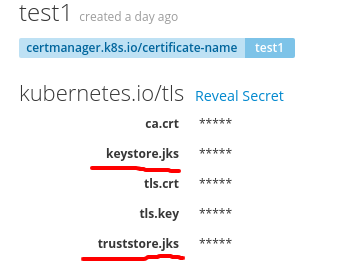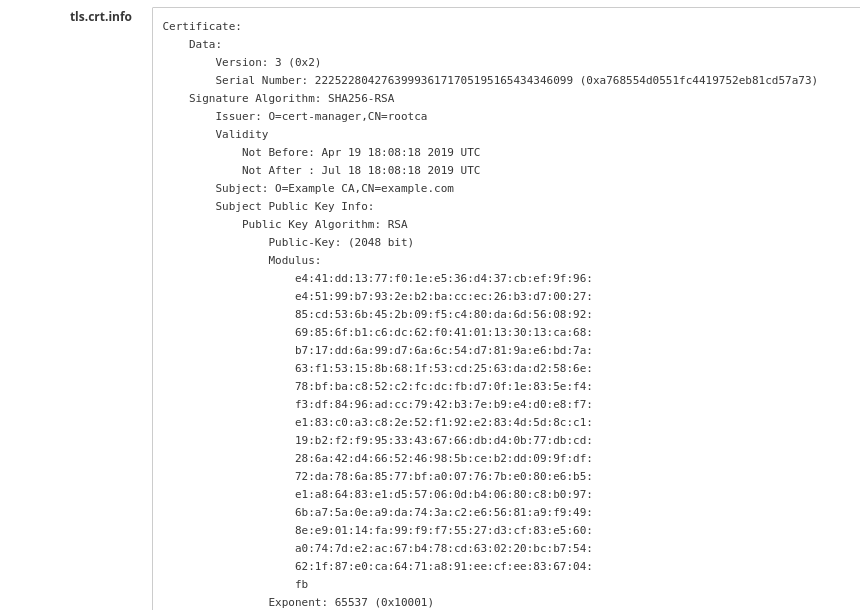Cert utils operator is a set of functionalities around certificates packaged in a Kubernetes operator.
Certificates are assumed to be available in a secret of type kubernetes.io/tls (other types of secrets are ignored by this operator).
By convention this type of secrets have three optional entries:
tls.key: the private key of the certificate.tls.crt: the actual certificate.ca.crt: the CA bundle that validates the certificate.
The functionalities are the following:
- Ability to populate route certificates
- Ability to create java keystore and truststore from the certificates
- Ability to show info regarding the certificates
- Ability to alert when a certificate is about to expire
- Ability to inject ca bundles in Secrets, ConfigMaps, ValidatingWebhookConfiguration, MutatingWebhookConfiguration and CustomResourceDefinition objects
All these feature are activated via opt-in annotations.
This is a cluster-level operator that you can deploy in any namespace, cert-utils-operator is recommended.
Here are the instructions to install the latest release
oc new-project cert-utils-operator
helm repo add cert-utils-operator https://redhat-cop.github.io/cert-utils-operator
helm repo update
export cert_utils_chart_version=$(helm search repo cert-utils-operator/cert-utils-operator | grep cert-utils-operator/cert-utils-operator | awk '{print $2}')
helm fetch cert-utils-operator/cert-utils-operator --version ${cert_utils_chart_version}
helm template cert-utils-operator-${cert_utils_chart_version}.tgz --namespace cert-utils-operator | oc apply -f - -n cert-utils-operator
rm cert-utils-operator-${cert_utils_chart_version}.tgzThis feature works on secure routes with edge or reencrypt type of termination.
This feature is activated with the following annotation on a route: cert-utils-operator.redhat-cop.io/certs-from-secret: "<secret-name>". Routes that are not secured (tls.termination field initialized to either edge or reencrypt) will be ignored even if they have the annotation.
The following fields of the route will be updated:
keywith the content oftls.key.certificatewith the content oftls.crt.caCertificatewith the content ofca.crt.
The destinationCACertificate can also be injected. To activate this feature use the following annotation: cert-utils-operator.redhat-cop.io/destinationCA-from-secret: "<secret-name>". The following field will be updated:
destinationCACertificatewith the content ofca.crt.
Note that the two annotations can point to different secrets.
This feature is activated with the following annotation on a kubernetes.io/tls secret: cert-utils-operator.redhat-cop.io/generate-java-keystores: "true".
When this annotation is set two more entries are added to the secret:
keystore.jks: this Java keystore contains thetls.crtandtls.keycertificate.trustsstore.jks: this Java keystore contains theca.crtcertificate.
Note that Java Keystore require the key to be in PKCS#8 format. It is a responsibility of the certificate provisioner to make sure the key is in this format. No validation is currently performed by the cert-utils operator.
A such annotated secret looks like the following:
The default password for these keystores is changeme. The password can be changed by adding the following optional annotation: cert-utils-operator.redhat-cop.io/java-keystore-password: <password>. The alias of the certificate inside the keystore is alias.
This feature is activated with the following annotation on a kubernetes.io/tls secret: cert-utils-operator.redhat-cop.io/generate-cert-info: "true".
When this annotation is set two more entries are added to the secret:
tls.crt.info: this entries contains a textual representation oftls.crtthe certificates in a similar notation toopenssl.ca.crt.info: this entries contains a textual representation ofca.crtthe certificates in a similar notation toopenssl.
A such annotated secret looks like the following:
This feature is activated with the following annotation on a kubernetes.io/tls secret: cert-utils-operator.redhat-cop.io/generate-cert-expiry-alert: "true".
When this annotation is set the secret will generate a Kubernetes Warning Event if the certificate is about to expire.
This feature is useful when the certificates are not renewed by an automatic system.
The timing of this alerting mechanism can be controller with the following annotations:
| Annotation | Default | Description |
|---|---|---|
cert-utils-operator.redhat-cop.io/cert-expiry-check-frequency |
7 days | with which frequency should the system check is a certificate is expiring |
cert-utils-operator.redhat-cop.io/cert-soon-to-expire-check-frequency |
1 hour | with which frequency should the system check is a certificate is expired, once it's close to expiring |
cert-utils-operator.redhat-cop.io/cert-soon-to-expire-threshold |
90 days | what is the interval of time below which we consider the certificate close to expiry |
Here is an example of a certificate soon-to-expiry event:
ValidatingWebhookConfiguration, MutatingWebhokConfiguration and CustomResourceDefinition types of objects (and possibly in the future others) need the master API process to connect to trusted servers to perform their function. I order to do so over an encrypted connection a CA bundle needs to be configured. In these objects the CA bundle is passed as part of the CR and not as a secret, and that is fine because the CA bundles are public info. However it may be difficult at deploy time to know what the correct CA bundle should be. Often the CA bundle needs to be discovered as a piece on information owned by some other objects of the cluster.
This feature allows you to inject the ca bundle from either a kubernetes.io/tls secret or from the service_ca.crt file mounted in every pod. The latter is useful if you are protecting your webhook with a certificate generated with the service service certificate secret feature.
This feature is activated by the following annotations:
-
cert-utils-operator.redhat-cop.io/injectca-from-secret: <secret namespace>/<secret name> -
cert-utils-operator.redhat-cop.io/injectca-from-service_ca: "true"
In addition to those objects, it is also possible to inject ca bundles from secrets to secrets and configmaps:
secrets: the secret must of type:kubernetes.io/tls. These types of secret must contain thetls.crtandtls.keykeys, but is this case those keys are going to be presumably empty. So it is recommended to create these secrets as follows:
apiVersion: v1
kind: Secret
metadata:
annotations:
cert-utils-operator.redhat-cop.io/injectca-from-secret: test-cert-utils/test1
name: test-inject-ca
namespace: test-cert-utils
type: kubernetes.io/tls
stringData:
tls.crt: ""
tls.key: ""confimaps: the ca bundle will be injected in this keyca.crt, here is an example:
apiVersion: v1
kind: ConfigMap
metadata:
annotations:
cert-utils-operator.redhat-cop.io/injectca-from-secret: test-cert-utils/test1
name: test-inject-ca-cm
namespace: test-cert-utilsProjected volumes can be use dto merge the caBundle with other pieces of configuration and or change the key name.
Execute the following steps to develop the functionality locally. It is recommended that development be done using a cluster with cluster-admin permissions.
Ensure go modules are active by defining this environment variable:
export GO111MODULE=onUsing the operator-sdk, run the operator locally:
OPERATOR_NAME="cert-utils-operator" operator-sdk run --local --operator-flags "--systemCaFilename $(pwd)/README.md" --namespace=""replace $(pwd)/README.md with a PEM-formatted CA if testing the CA injection functionality.
To release execute the following:
git tag -a "<version>" -m "release <version>"
git push upstream <version>use this version format: vM.m.z


